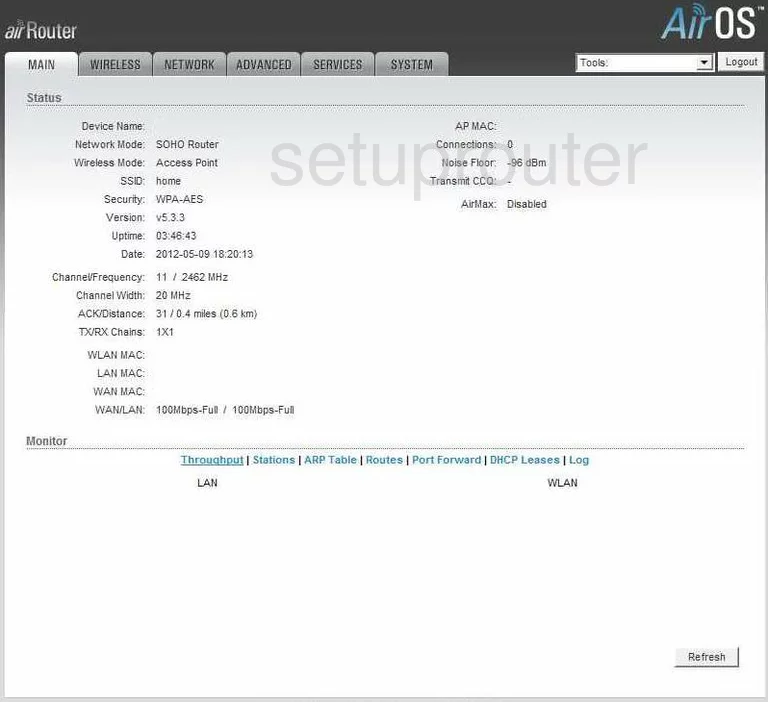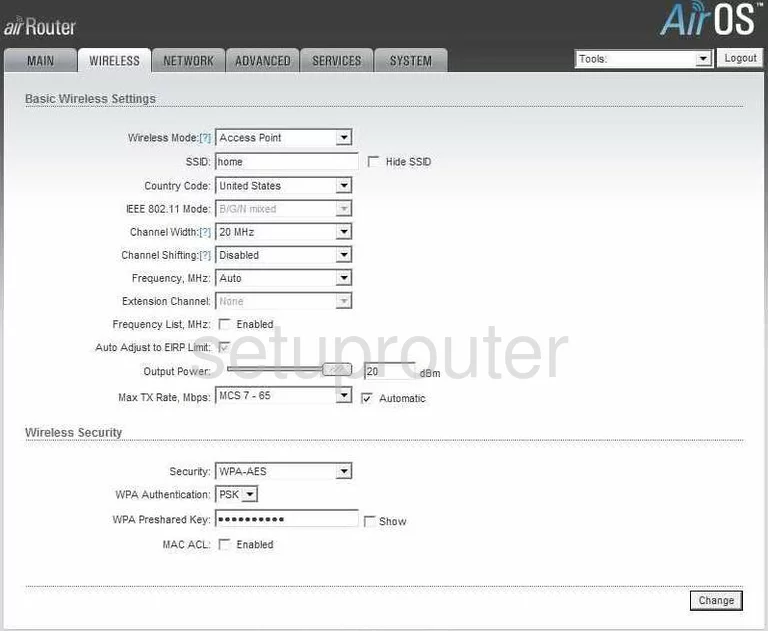The AirRouter AirOS router is considered a wireless router because it offers WiFi connectivity. WiFi, or simply wireless, allows you to connect various devices to your router, such as wireless printers, smart televisions, and WiFi enabled smartphones.
Other AirRouter AirOS Guides
This is the wifi guide for the AirRouter AirOS. We also have the following guides for the same router:
- AirRouter AirOS - How to change the IP Address on a AirRouter AirOS router
- AirRouter AirOS - AirRouter AirOS Login Instructions
- AirRouter AirOS - AirRouter AirOS User Manual
- AirRouter AirOS - How to change the DNS settings on a AirRouter AirOS router
- AirRouter AirOS - How to Reset the AirRouter AirOS
- AirRouter AirOS - Information About the AirRouter AirOS Router
- AirRouter AirOS - AirRouter AirOS Screenshots
WiFi Terms
Before we get started there is a little bit of background info that you should be familiar with.
Wireless Name
Your wireless network needs to have a name to uniquely identify it from other wireless networks. If you are not sure what this means we have a guide explaining what a wireless name is that you can read for more information.
Wireless Password
An important part of securing your wireless network is choosing a strong password.
Wireless Channel
Picking a WiFi channel is not always a simple task. Be sure to read about WiFi channels before making the choice.
Encryption
You should almost definitely pick WPA2 for your networks encryption. If you are unsure, be sure to read our WEP vs WPA guide first.
Login To The AirRouter AirOS
To get started configuring the AirRouter AirOS WiFi settings you need to login to your router. If you are already logged in you can skip this step.
To login to the AirRouter AirOS, follow our AirRouter AirOS Login Guide.
Find the WiFi Settings on the AirRouter AirOS
If you followed our login guide above then you should see this screen.

You begin on the Main page of the AirRouter AirOS. To configure your router's security settings, click the option at the top of the page labeled WIRELESS.
Change the WiFi Settings on the AirRouter AirOS

You should now be on a page similar to the one you see above.
- Wireless Mode - Use this drop down menu to choose Access Point.
- SSID - This is the name that identifies your network from those around you. This name should be original but not point to you. Do not use any personal information in this name. For more detailed information on the SSID check out our guide titled Wireless name.
- Country Code - Choose the country that you are living in.
- IEEE 802.11 Mode - This should be left at the default. It should be at B/G/N mixed.
- Channel Width and Channel Shifting - Leave both of these at their default value.
- Frequency, MHz. The channel can be changed if your are receiving interference or you are not getting the reception you think you should. In the United States there are 11 channels to choose from. Of these channels there are only three that should be used by everyone. Choose channel 1,6, or 11. On this router they are 2412,2437, or 2462. For more information on the reasons you need to use these three channels, check out our guide titled WiFi channels.
- Leave everything else in this section the way it is. Skip down to the Wireless Security section.
- Security - This is giving you the choice of what type of security you would like to use. Pick the option of WPA2-AES. This is the strongest security available today. For more information on the different types of security available, check out our guide titled WEP vs. WPA.
- WPA Authentication - Use the drop down menu to choose the option of PSK. PSK means Pre-shared Key. This means you want to use a password to access your network.
- WPA Preshared Key - Enter your password in this box. This password is very important to the security of your network. Create a long and seemingly random password. This password should not contain any personal information. It should not contain any word found in any dictionary, regardless of the language. Do include symbols, capital letters, and numbers. For help in creating a strong yet memorable password, check out our guide on How to choose a strong password.
- When you are finished, click the Change button at the bottom of the page.
Possible Problems when Changing your WiFi Settings
After making these changes to your router you will almost definitely have to reconnect any previously connected devices. This is usually done at the device itself and not at your computer.
Other AirRouter AirOS Info
Don't forget about our other AirRouter AirOS info that you might be interested in.
This is the wifi guide for the AirRouter AirOS. We also have the following guides for the same router:
- AirRouter AirOS - How to change the IP Address on a AirRouter AirOS router
- AirRouter AirOS - AirRouter AirOS Login Instructions
- AirRouter AirOS - AirRouter AirOS User Manual
- AirRouter AirOS - How to change the DNS settings on a AirRouter AirOS router
- AirRouter AirOS - How to Reset the AirRouter AirOS
- AirRouter AirOS - Information About the AirRouter AirOS Router
- AirRouter AirOS - AirRouter AirOS Screenshots